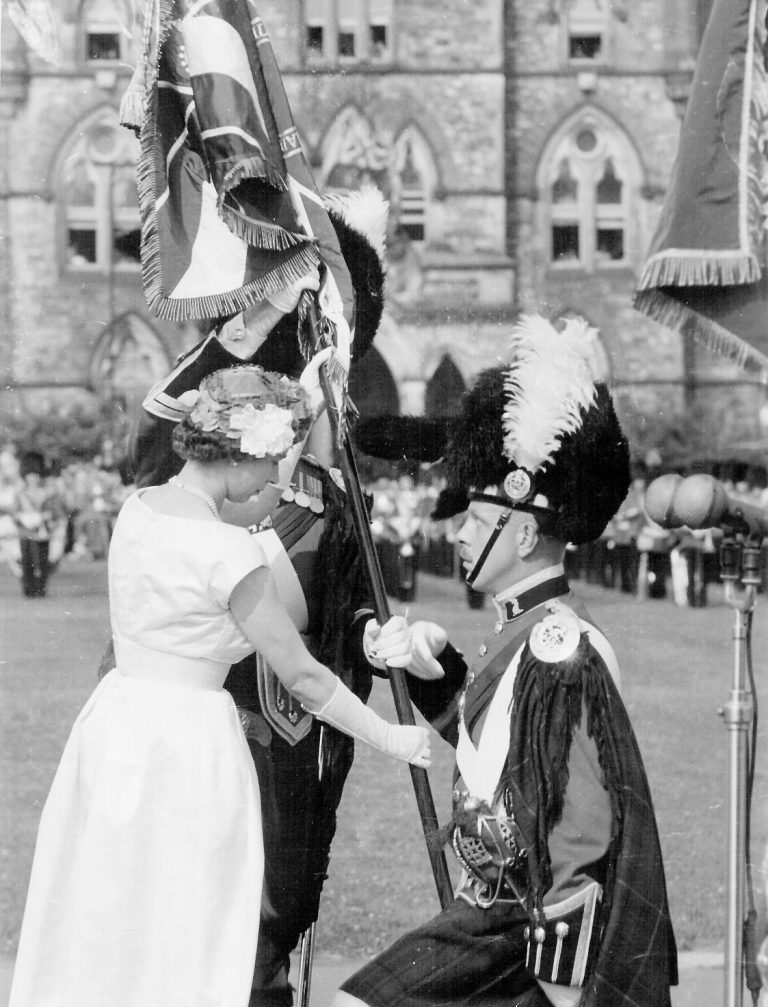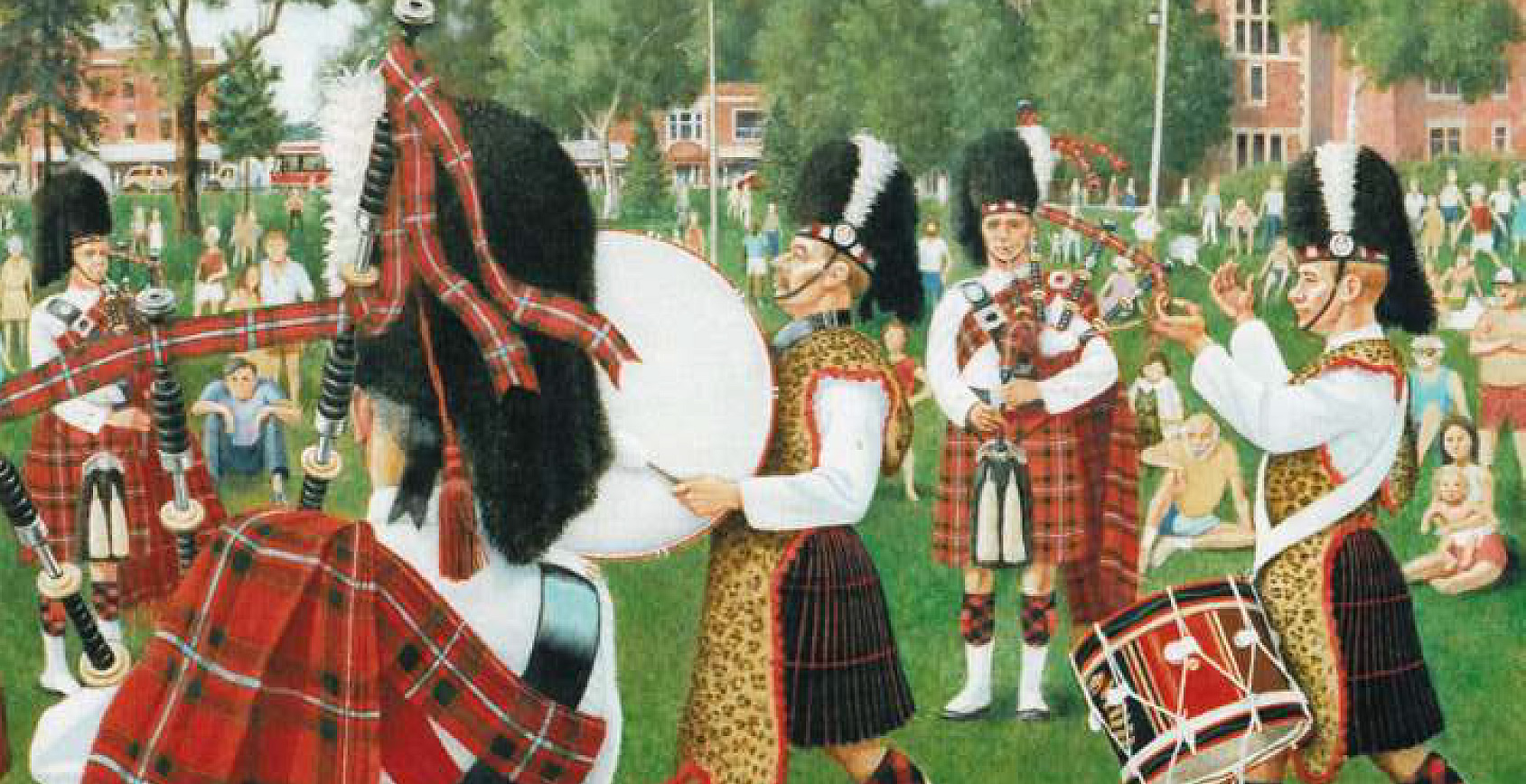48th Highlanders of Canada – Kew Gardens, Toronto
The military’s record in our region helps us understand our connection with the 48th Highlanders of Canada and The Crown. When we examine Canada’s existence and development within the British Commonwealth, a lot is revealed.
The province of Upper Canada was established in 1791 by the Kingdom of Great Britain. It included all of modern day Southern Ontario and it was the primary destination of loyalist refugees and settlers from the United States after the American Revolution.
In 1812, war broke out between Great Britain and the United States. This took place largely in the northeastern part of the U.S. and along the shores of the Great Lakes and St. Lawrence River.
The 48th Lennox and Addington Battalion of Infantry was authorized on September 14, 1866. Their headquarters were at Napanee ON with companies located there as well as those on Amhearst Island, in Bath, Odessa, Ernestown and Tamworth. It was the following year (1867) that marked Confederation – the year that Canada officially became a country.
Queen Victoria reigned as sovereign of the British Commonwealth from 1837 until 1901. It was during this period that the Lennox and Addington Battalion was established. It disbanded 14 years later on September 3, 1880.
The Famous 48th
The 48th Highlanders of Canada (perpetuated by the 15th, 92nd and 134th Battalions during WWI [Highlanders] were authorized October 16, 1891. At the time they were known as the 48th Battalion [Highlanders]. The Regiment was re-designated multiple times between 1920 and 1945 and today they remain designated as the 48th Highlanders of Canada.
At least 67 of their members served as part of the 2nd Special Service Battalion, Royal Canadian Regiment of Infantry, during the Boer War in South Africa between 1899 and 1902. Battle Honours (the 48th Highlanders of Canada hold more of these than any other Reserve Regiment) were earned in this campaign, however, the Highlanders weren’t officially given their number until 1900. At the time application was made, the first number available (48) was assigned, thus the main connection to our area.
WWI raged between 1914 and 1918. This is known as the “Great War” and the “War to End All Wars”. During this time the King of the United Kingdom was George V (1910 -1936). Records show that the world-wide pandemic known as the Spanish Flu occurred (essentially) between 1918 and 1920. There is some debate about the actual origin of this virus but there is little doubt that the spread of it can be attributed, at least part, to the returnees of WWI.
After his brother Edward abdicated the throne, Albert Frederick Arthur George Windsor became King George VI. He reigned from 1936 until 1952. Interestingly, the National War Memorial in Ottawa was dedicated by the King in 1939. It was originally intended to honour the fallen of WWI. Sadly, WWII broke out later that year and continued until 1945.
King George VI’s eldest child (Elizabeth) became our Queen upon the death of her father in 1952. It is little known that Princess Elizabeth became the Colonel-in-Chief of the 48th Highlanders on December 1, 1947 approximately six years before she became Queen!

The Colour Party on Parliament Hill receiving new colours, July 1, 1959
Upon her death, late in 2022, the Reign of Queen Elizabeth II ended and so did her military appointments. Many questions arose at the time but the ties to Canada were not among them. Her Majesty Queen Elizabeth II held 3 appointments to the Canadian Army as Princess Elizabeth and at least 11 as Her Majesty the Queen.
An excellent special essay regarding the Royal appointment of Her Majesty the Queen was published in “THE FALCON” (Official Journal of the 48th Highlanders of Canada) Winter/Spring Issue #28 in 2014. This article was recently referred to as a source of information in answering some of the questions arising since the death of Queen Elizabeth.
You can find this essay on page 19 by clicking here: https://museum.48thhighlanders.ca/wp-content/uploads/2021/07/28Falcon_Summer2014.pdf
Another excellent source of information about the famous 48th can be found here:
https://museum.48thhighlanders.ca/regimental-publications/
At Her Majesty’s funeral, a contingent of military personnel from around the commonwealth was represented. Leading were four black horses given to the Queen by Canada, each ridden by a member of the Royal Canadian Mounted Police. This place of honour is indicative of the strength of the bond between the Crown and Canada.
In May of 2012, a blog was written by Dave Trafford about the Memorial Cup national championship of the Canadian Hockey League. For those who may have missed it, here is what he wrote:
“The thing that struck me most about this year’s Memorial Cup and the hometown Majors is this Championship is played in honour of our war vets and war dead. It’s the MEMORIAL Cup and, ironically, we seem to forget that.
To make the point this year, the official logo includes a poppy and you’ll notice the bench staff for the Majors was wearing poppies on their lapels during the tournament.
If you’re of a certain age, you will know there used to be Memorial Arenas all across this country, (I played my first organized game in Soo Memorial Gardens, with its iconic Memorial Tower) where the names of the local lads turned “vets” were posted in the lobby. It was somehow fitting that the local sports shrine that was so central to small towns across the country would be the place of honour to commemorate these young men, to celebrate their sacrifice and commitment to Canada.
Sadly many of those old barns are no longer standing. They’ve been replaced with newer buildings over the years and most of them have been renamed. They’re no longer MEMORIAL arenas or community halls or swimming pools. The Soo Memorial Gardens was torn down years ago and replaced with the Steelback Centre. (Steelback breweries went bankrupt shortly afterwards. Now a steel company owns the naming rights.)
Naming the new rinks after a supportive sponsor or after some notable local citizen is all good in and of itself. But, in so doing, we’ve lost touch and even forgotten the young men and women who never came home, who never had the chance to take one more spin around the rink or cheer for the local team.
This is just something to remember when they hand out the MEMORIAL CUP.”
Conclusion
It should be noted that during the Italian Campaign of WWII, another connection was made to our region. The Hastings and Prince Edward Regiment (Hasty Ps), now headquartered in Belleville ON, fought alongside the 48th and many other distinguished Canadian troops against the best forces the enemy had to offer.
When we speak about our history and the connections to our past, whether they are about conflict, sport, royalty or pioneer times, one thing is clear:
Our stories are real. They are connected on many levels and they have value and meaning. They must be shared and the lessons must be passed to future generations. It is fair to say that that although it may have been “their” war, it is “our” legacy. We must never forget and we must share the story.
If you would like to learn more about the 15th Battalion Canadian Expeditionary Force and the inspiration for the naming of the Festubert Post Office on “Mike’s Island” (Skootamata Lake) visit: https://15thbattalioncef.ca/actions/festubert/
Note: Special thanks to Heather Wilson, an Archivist at the Museum of Lennox and Addington in Napanee who provided a “Guide to Sources Relating to Canadian Militia (Infantry, Cavalry, Armored)”.


0 Comments